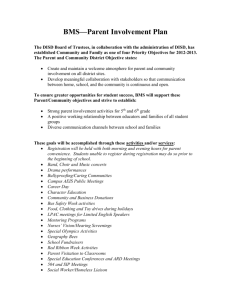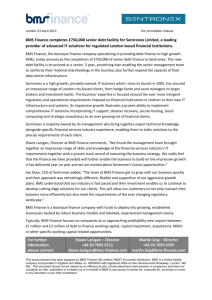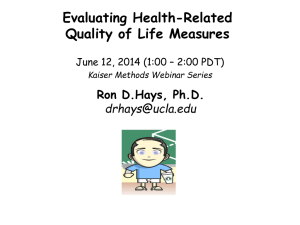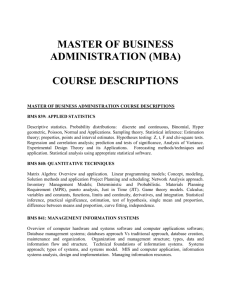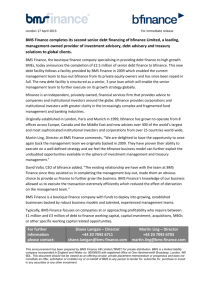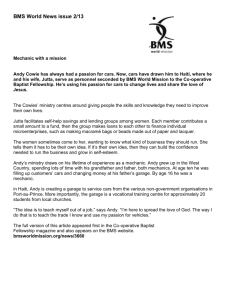Course Overview - UCLA UCLA Center for Maximizing Outcomes
advertisement
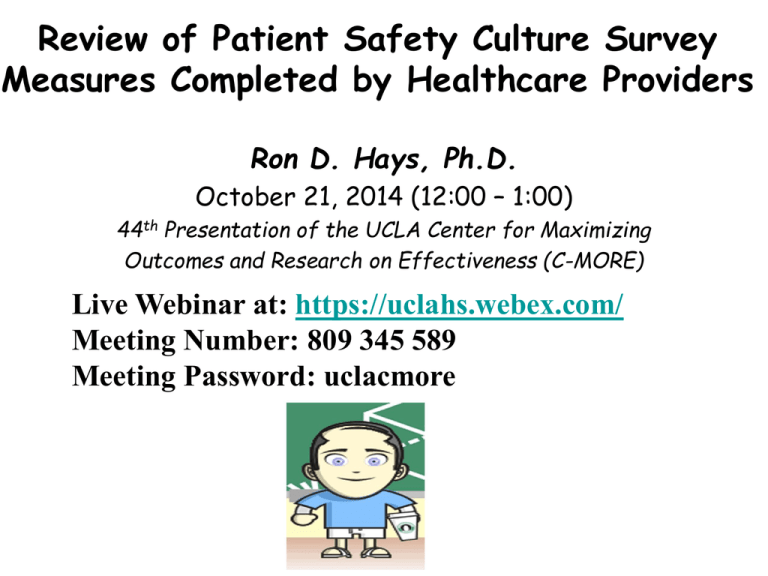
Review of Patient Safety Culture Survey Measures Completed by Healthcare Providers Ron D. Hays, Ph.D. October 21, 2014 (12:00 – 1:00) 44th Presentation of the UCLA Center for Maximizing Outcomes and Research on Effectiveness (C-MORE) Live Webinar at: https://uclahs.webex.com/ Meeting Number: 809 345 589 Meeting Password: uclacmore CMORE http://cmore.med.ucla.edu/index.htm 05/11/2010 Robert Kaplan, PhD How Do We Interpret Unexpected Findings From Large Clinical Trials? 06/08/2010 Brian Mittman, PhD Achieving the Promise of CER: The Role of Implementation Science 07/13/2010 Benjamin Craig, PhD Comparing Health Outcomes in Comparative Effectiveness (CHOICE) Research: Do preferences 2 matter? Motivation for Today’s Topics • Agency for Healthcare Research and Quality (AHRQ) Safety Culture Conference funded by R13 to: – Jason Etchegaray, Ph.D. – University of Texas-Houston Medical School • Held October 2, 2014 3 Putting Safety in Context* Advances in medicine have led to positive outcomes: Most childhood cancers are curable AIDS is now a chronic disease Life expectancy has increased 10 years since the 1950s However, sponges are still found inside patients’ bodies after operations. *Note: Slide from Comprehensive Unit-based Safety Program (CUSP) 4 http://www.ahrq.gov/professionals/education/curriculum-tools/cusptoolkit/index.html Health Care Defects in U.S.* 7% of patients suffer a medication error2 On average, every patient admitted to an intensive care unit suffers an adverse event3,4 44k—99k die in hospitals/year as the result of medical errors5 > half a million develop catheter-associated urinary tract infections, resulting in 13,000 deaths/ year6 Nearly 100k die from health care-associated infections (HAIs)/year and the cost of HAIs is $28 to $33 billion/year7 30k—62k deaths from central line-associated 5 blood stream infections/year8 Patient Safety Culture Measures • AHRQ Hospital Survey on Patient Safety Culture (HSOPSC or SOPS) – http://www.ahrq.gov/legacy/qual/patientsafetyc ulture/hospsurvindex.htm • Safety Attitudes Questionnaire (SAQ) – https://med.uth.edu/chqs/surveys/safetyattitudes-and-safety-climate-questionnaire/ • Patient Safety Climate in Healthcare Organizations (PSCHO) Survey – http://www.midss.org/content/patient-safetyclimate-healthcare-organizations-pscho 6 AHRQ Hospital Survey on Patient Safety Culture (HSOPSC or SOPS) • 42 items measuring 12 domains – – – – – – – – – – – – Supervisor/manager expectations (k = 4) Organizational learning/Cont. improve (k = 3) Teamwork within units (k = 4) Teamwork across units (k = 4) Communication openness (k = 3) Feedback/comm. about error (k = 3) Non-punitive response to error (k = 3) Staffing (k = 4) Management support for safety (k = 3) Handoffs/transitions (k = 4) Frequency of events reports (k = 3) Overall perceptions of patient safety (k = 4) 7 2012 Comparative Database • 1,128 hospitals – 66% non-teaching – 80% non-government • 567,703 hospital staff respondents – Mean of 503 surveys/hospital – 53% response rate • Respondents – 35% registered nurse, or licensed vocational nurse/licensed practical nurse – 11% technician (e.g., EKG, lab, radiology) – 8% administration/management – 6% attending, resident, physician assistant, or nurse practitioner 8 9 Areas in need of Improvement • Non-punitive response to error (44% positive) – Staff feel that their mistakes and event reports are not held against them and that mistakes are not kept in their personal file. • Handoffs and tradeoffs (45% positive) – Important patient care information is transferred across hospital units and during shift changes • Staffing (56% positive) – Enough staff to handle the workload and work hours are appropriate to provide best care. 10 Safety Attitudes Questionnaire (SAQ) • 30 items measuring 6 domains – Safety climate (k = 7) – Teamwork climate (k = 6) – Perceptions of management (k = 4) – Job satisfaction (k = 5) – Working conditions (k = 4) – Stress recognition (k = 4) 11 Patient Safety Climate in Healthcare Organizations (PSCHO) Survey • 31 items measuring 7 domains – Senior managers’ engagement (k = 7) – Organizational resources (k = 3) – Overall emphasis on patient safety (k = 3) – Unit safety norms (k = 7) – Unit support/recognition for safety effort (k = 4) – Fear of blame (k = 2) – Fear of shame (k = 5) 12 Qualitative Observations (HSOPSC) • Response options Please indicate your agreement or disagreement with the following statements about your work area/unit. Think about your hospital work area/unit… Strongly Strongly Disagree Disagree Neither Agree Agree 1. People support one another in this unit ...................................................... 1 2 3 4 5 2. We have enough staff to handle the workload ........................................... 1 2 3 4 5 3. When a lot of work needs to be done quickly, we work together as a team to get the work done .......................................................................... 1 2 3 4 5 4. In this unit, people treat each other with respect ........................................ 1 2 3 4 5 5. Staff in this unit work longer hours than is best for patient care ................. 1 2 3 4 5 13 Qualitative Observations (SAQ) 14 Qualitative Observations (PSCHO) 15 Reliability Model Two-way random Twoway mixed Oneway Reliability N ( MS BMS MS EMS ) NMS BMS MS JMS MS EMS MS BMS MS EMS MS BMS MS BMS MSW MS MS BMS Intraclass Correlation MS BMS MS EMS MS BMS (k 1) MS EMS k ( MS JMS MS EMS ) / N MS BMS MS EMS MS BMS (k 1) MS EMS MS BMS MSW MS MS BMS (k 1) MSW MS BMS = Between Ratee Mean Square N = n of ratees WMS = Within Mean Square k = n of items or raters JMS = Item or Rater Mean Square EMS = Ratee x Item (Rater) Mean Square 16 Reliability Formulas Model Two-way random Twoway mixed Oneway Reliability N ( MS BMS MS EMS ) NMS BMS MS JMS MS EMS MS BMS MS EMS MS BMS MS BMS MSW MS MS BMS Intraclass Correlation MS BMS MS EMS MS BMS (k 1) MS EMS k ( MS JMS MS EMS ) / N MS BMS MS EMS MS BMS (k 1) MS EMS MS BMS MSW MS MS BMS (k 1) MSW MS BMS = Between Ratee Mean Square N = n of ratees WMS = Within Mean Square k = n of items or raters JMS = Item or Rater Mean Square EMS = Ratee x Item (Rater) Mean Square 17 Reliability Formulas Model Two-way random Twoway mixed Oneway Reliability N ( MS BMS MS EMS ) NMS BMS MS JMS MS EMS MS BMS MS EMS MS BMS MS BMS MSW MS MS BMS Intraclass Correlation MS BMS MS EMS MS BMS (k 1) MS EMS k ( MS JMS MS EMS ) / N MS BMS MS EMS MS BMS (k 1) MS EMS MS BMS MSW MS MS BMS (k 1) MSW MS BMS = Between Ratee Mean Square N = n of ratees WMS = Within Mean Square k = n of items or raters JMS = Item or Rater Mean Square EMS = Ratee x Item (Rater) Mean Square 18 rwg (i) • 1 – (Sxj2 / sigmaEU2) – Within-group interrater reliability for Xj (Proportion of non-error variance) – Sxj2 = observed variance on Xj – SigmaEU2 = variance on Xj if all judgements were due to random measurement error • Expected error variance based on uniform distribution. • (NCAT2 – 1)/12 • James et al. (1984, J App Psych) 19 Item-scale correlation matrix Item #1 Item #2 Item #3 Item #4 Item #5 Item #6 Item #7 Item #8 Item #9 Depress Anxiety 0.50* 0.50* 0.50* 0.50 0.50 0.50 0.50 0.50 0.50 0.50 0.50 0.50 0.50* 0.50* 0.50* 0.50 0.50 0.50 Anger 0.50 0.50 0.50 0.50 0.50 0.50 0.50* 0.50* 0.50* *Item-scale correlation, corrected for overlap. 20 Item-scale correlation matrix Item #1 Item #2 Item #3 Item #4 Item #5 Item #6 Item #7 Item #8 Item #9 Depress Anxiety 0.80* 0.80* 0.80* 0.20 0.20 0.20 0.20 0.20 0.20 0.20 0.20 0.20 0.80* 0.80* 0.80* 0.20 0.20 0.20 Anger 0.20 0.20 0.20 0.20 0.20 0.20 0.80* 0.80* 0.80* *Item-scale correlation, corrected for overlap. 21 Confirmatory Factor Analysis Item #1 Item #2 Item #3 Item #4 Item #5 Item #6 Item #7 Item #8 Item #9 Depress Anxiety 0.80* 0.80* 0.80* 0.00 0.00 0.00 0.00 0.00 0.00 0.00 0.00 0.00 0.80* 0.80* 0.80* 0.00 0.00 0.00 Anger 0.00 0.00 0.00 0.00 0.00 0.00 0.80* 0.80* 0.80* *Factor loading. 22 Validity Does scale represent what it is supposed to be measuring? • Singer et al. (2009) – Hospitals (91 hospitals, 18,223 respondents) with better safety climate overall had lower relative incidence of patient safety indicators • PSIs recommended by AHRQ Quality Indicators Support Team (see Appendix for list) • 2004 MEDPAR data – Frontline personnel’s (not senior manager’s) perceptions of better safety climate were associated with lower incidence of patient safety indicators 23 New Directions • • • • • Standardized General Population Metric Category Response Curves Computer Adaptive Testing Differential Item Functioning Linking of Different Measures 24 T-score Metric • T Score referenced to US Hospitals Mean = 50 SD = 10 T = 50 + (z * 10) 25 CATEGRORY RESPONSE CURVE Item Responses and Trait Levels Person 1 Item 1 Person 2 Person 3 Item 2 www.nihpromis.org Item 3 Trait Continuum Computer Adaptive Testing (CAT) PROMIS Physical Functioning vs. “Legacy” Measures 10 20 30 40 50 60 70 30 Differential Item Functioning (DIF) • Probability of choosing each response category should be the same for those who have the same estimated scale score, regardless of other characteristics • Evaluation of DIF by subgroups 31 DIF (2-parameter model) 1 Men Probability of "Yes" Response 0.9 0.8 0.7 0.6 Women White 0.5 0.4 Slope DIF Location DIF 0.3 0.2 AA 0.1 0 -4 -3.5 -3 -2.5 -2 I cry when upset -1.5 -1 -0.5 0 0.5 1 1.5 2 2.5 3 3.5 4 I get sad for no reason Higher Score = More Depressive Symptoms 32 Linking of Difference Patient Safety Culture Measures • Equipercentile linking of scores – Scores associated with equivalent % – X scores and Y scores correspond to same number of SDs above or below the mean – Matches two cumulative distribute functions to each other either via smooth functions or nonparametrically • IRT linking – Map onto logistic scales 33 Linking Assumptions • Instruments are measuring essentially the same thing (unidimensional) • Scores from the two instruments are highly correlated (> 0.80); compare actual with estimated scores • Subgroup invariance (standardized root mean square deviation) 34 Etchegaray & Thomas (2012) • R-squared for SAQ teamwork = 54% 0.83 + 0.34* HSOPSteamwork + 0.51* HSOPScommun. • R-squared for SAQ safety = 42% 1.63 + 0.65* HSOPorganizational learning • Correlations among SAQ and HSOPS – Etchegaray & Thomas (2012) Table 4 – Predominantly unidimensional • 8.2, 1.28 and 0.96 are 1st 3 principal components – If two factors rotated 2nd factor shows common variance among 5 HSOPS scales • Teamwork within, non-punitive, number of events reported, expectations, and staffing 35 Bibliography DiCuccio, M. H. (2014). The relationship between patient safety culture and patient outcomes: A systematic review. J Patient Saf, epub. Etchegary, J. M., & Thomas, E. J. (2012). Comparing two safety culture surveys: Safety Attitudes Questionnaire and Hospital Survey on Patient Safety. BMJ Qual Sat, 21, 490-498. Morello, R. T. et al. (2013). Strategies for improving patient safety culture in hospitals: A systematic review. BMJ Qual Saf, 22, 11-18. Sammer, C. E., Lykens, K., Singh, K. P., Mains, D. A., & Lackan, N. A. (2010). What is patient safety culture? A review of the literature. Journal of Nursing Scholarship, 42, 156-165. Sexton, J. B. et al. (2011). Assessing and improving safety climate in a large cohort of intensive care units. Crit Care Med, 39, 934-939. Sexton, J. B. et al. (2006). The Safety Attitudes Questionnaire: Psychometric properties, benchmarking data, and emerging research. BMC Health Services Research, 6, 44. Singer, S. et al. (2009). Relationship of safety climate and safety performance in hospitals. Health Services Research, 44, 399-421. Singer, S. et al. (2007). Workforce perceptions of hospital safety culture: Development and validation of the Patient Safety Climate in Healthcare Organizations Survey. Health Services Research, 42, 1999-2021 Sorra, J. S., & Dyer, N. (2010). Multilevel psychometric properties of the AHRQ hospital survey on patient safety culture. BMC Health Services Research, 10, 199. 36 drhays@ucla.edu (310-794-2294). http://gim.med.ucla.edu/FacultyPages/Hays/ Appendix: 12 PSIs in Singer et al. (2009) • • • • • • • • • • • • Complications of anesthesia Decubitus ulcer Inatrogenic pneumothorax Infection due to medical care Postoperative hip fracture Postop hemorrhage or hematoma Postop physio metabol derangmnt Postop respiratory failure Postop PE or DVT Postop sepsis Postop wound dehiscence Accidental puncture/lacertaion 38 Previous CMORE Talks http://cmore.med.ucla.edu/index.htm 05/11/2010 Robert Kaplan, PhD How Do We Interpret Unexpected Findings From Large Clinical Trials? 06/08/2010 Brian Mittman, PhD Achieving the Promise of CER: The Role of Implementation Science 07/13/2010 Benjamin Craig, PhD Comparing Health Outcomes in Comparative Effectiveness (CHOICE) Research: Do preferences 39 matter? CMORE 08/10/2010 Robert Brook, MD, ScD Can We Establish a Business Case for Comparative Effectiveness Research? 09/14/2010 Brennan Spiegel, MD MSHS, FACG Introduction to Cost-Effectiveness Analysis: How to Figure out if the Juice is Worth the Squeeze. 10/12/2010 Michael Ong, MD, PhD Comparative Effectiveness Research on Reducing Heart Failure Readmissions. 40 CMORE 11/09/2010 Teryl Nuckols, MD Utilization of care as a criteria for comparative effectiveness research. 12/14/2010 Francesco Chiappelli, PhD Toward Clinically Relevant Complex Systematic Reviews (CRCSR's), and beyond: Recent Milestones and Remaining Challenges. 01/11/2011 Ken Wells, MD, MPH Community-partnered comparative effectiveness research in mental health. 41 CMORE 02/08/2011 John Adams, PhD Physician Cost Profiling. 03/08/2011 Mark Litwin, MD MPH Caring for the Uninsured in California with Prostate Cancer. 04/12/2011 Katherine Kahn, MD, PhD Approach to the Evaluation of the Effectiveness of Decision Support Systems for Advanced Imaging Procedures. 42 CMORE 05/10/2011 Patricia Ganz, MD Comparative Effectiveness and Studies of Breast Cancer Outcomes and Quality. 07/12/2011 Lisa Rubenstein, MD Quality Improvement and Implementation Science in the Era of Comparative Effectiveness. 08/16/2011 Sarah Starks Cost and Effectiveness of Full Service Partnerships: Assertive Community Treatment of Severe Mental Illness 43 CMORE 09/13/2011 John Romley, PhD Hospital Spending and Inpatient Mortality: Evidence from California. 10/18/2011 Emmett Keeler, PhD Cost effectiveness of lung cancer screening in the NLST. 11/08/2011 Ian Coulter, PhD Overview and Critique of Comparative Effectiveness Research. 44 CMORE 12/20/2011 Pamela Davidson, PhD Improving Safety through Intervention, Innovation, Policy Analysis, and Workforce Development. 01/17/2012 Cheryl Damberg, PhD Potential Unintended Consequences in Pay for Performance Programs. 02/21/2012 Ron Anderson, PhD The State of Comparative Effectiveness Research at the National Level 45 CMORE 03/20/2012 Roger Lewis, MD, PhD Adaptive Clinical Trials 04/17/2012 Dominick Frosch, PhD Communicating Comparative Effectiveness Research Results to Patients 05/15/2012 Kevin Grumbach, MD The Translational Research Challenge: Improving the Health of the Community. 46 CMORE 06/19/2012 Robin Clarke, MD Incorporating Stakeholders: Examining the Medical Home Through an Adaptation of the Modified Delphi Process. 07/17/2012 David Reuben, MD UCLA Alzheimer's and Dementia Care: Comprehensive, coordinated, patient-centered. 08/21/2012 Brian Mittman, PhD "Methods Matter": Goals and Content for the First PCORI Methodology Report and Standards. 47 CMORE 09/18/2012 PCORI Discussion Panel on PatientEngagement (Tim Carey and Paul G. Shekelle) How can we meet or surpass the bar raised by PCORI on stakeholder engagement in our research - from study design to dissemination. 10/16/2012 Christopher Saigal, MD MPH Improving Decision Making at the Point of Care: Opportunities and Challenges. 48 CMORE 12/4/12 Douglas Bell, MD PhD Value of Information: A Brief Summary. Lenore Arab, Phd, MS PCORI Update: Board of Governors Recap 01/15/2013 Wendy Slusser, MD How to Build Stakeholder Engagement into Studies 02/19/2013 Lenore Arab, PhD MS What PCORI Wants: An Open Discussion of PCORI Reviews, PCORI Reviewers, and PCORI Successes. 49 CMORE 03/19/2013 Mellissa Withers, PhD, MHS Qualitative Research. 04/16/2013 Bruce Dobkin, MD UCLA Wireless Health Institute can Help Investigators. 05/21/2013 Alison Hamilton, PhD, Brian Mittman, PhD, and Gail Wyatt, PhD Studying Effectiveness and Implementation of Evidence-Based, Research-Developed Programs in Routine Care Settings: Tradeoffs and Challenges50 in Study Designs and Methods. CMORE 11/5/2013 Matthew Press, MD MSc Collaboration Between Clinicians: Assessing its Quality and Impact 12/17/2013 José Calderón, MD Improving diabetes health literacy by animation. 2/18/2014 Amy D. Waterman, PhD Expanding Living Donor Transplantation Through Improved Education. 51 CMORE 3/18/2014 Rich Baker, MD The 30% solution? Challenging an underlying assumption of the ACA and its implication for successful health reform. 4/15/2014 Loren Miller, MD MPH Recurrent urinary tract infections among women: comparative effectiveness of 5 prevention and management strategies using a Markov chain Monte Carlo model. 5/20/2014 Adam Richards, MD Health Equity Metrics to Ameliorate Health Disparities Inequity: A User's Guide. 52 CMORE 6/17/2014 Ka-kit Hui, MD The Potential Value of the Integrative Health Paradigm in Health Outcomes Research. 9/16/2014 John Adams, PhD Using Item Response Theory to Summarize Health Care Quality Measures. 53

